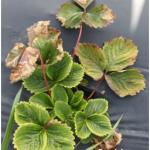Strawberry IPM- Strawberry Mottle Virus and Strawberry Mild Yellow Edge Virus
Strawberry viruses can cause significant crop loss, particularly in areas where strawberries are grown as perennial crops. Recently, Strawberry mottle virus (SMoV) and Strawberry mild yellow edge virus (SMYEV) have become pathogens of special concern for growers in the northeastern US. In a recent survey of 11 viruses in field-grown strawberries from throughout the US and Canada, SMoV and SMYEV were the viruses most frequently detected in plants from the Northeast.
Signs and symptoms
SMoV alone can cause up to 30% reduction in yield and runner production; however, strawberry plants infected with a single virus seldom display visible disease symptoms. Symptoms can be severe when plants are infected with both viruses, or in multiple infections with other viruses. These symptoms may include stunting, chlorosis and/or necrosis on newer leaves, reddening of older leaves, leaf distortion, and diminished yield.
Life Cycle
The strawberry aphid, Chaetosiphon fragaefolii, is the major vector for both SMoV and SMYEV. Chaetosiphon jacobi and C. minor may also transmit both viruses; in addition, C. gossypii can transmit SMoV. Strawberry aphids overwinter as black, oval eggs up to 0.5 mm in length on the undersides of leaves close to the ground. Once hatched, nymphs will move to younger leaves. Nymphs will mature and begin giving birth to live young within about two weeks. As the population increases, adult aphids will grow wings and become more mobile, enabling them to spread viruses further.
Although they are both transmitted by aphids, these viruses have different relationships with their vector. SMoV is transmitted in a semi-persistent manner. The virus enters the aphid’s foregut, but not the hindgut. It does not reproduce inside the vector. Aphids acquire the virus within minutes of beginning to feed on an infected plant and can transmit the virus for 2-3 hours. SMYEV is transmitted in a persistent manner. The virus enters the aphid’s hindgut and can reproduce there; the aphid therefore remains infective for the span of its life. Aphids pick up the virus from infected plants in about 2 hours and can transmit it to uninfected plants after 8 hours.
In addition to aphids, both viruses may also be spread through propagation and dissemination of infected plant material. All species of Fragaria are believed to be susceptible to both viruses.
Management
Purchase virus-free plants. See https://nationalcleanplantnetwork.org for more information.
Begin monitoring fields for aphids as soon as mulch is removed in spring. Please see https://newenglandvfc.org/wp-content/uploads/2022/09/2015_Proceedings_Combined_PDF.pdf for a detailed description of monitoring procedures.
Control aphids when necessary. Please see https://ag.umass.edu/fruit/ne-small-fruit-management-guide for recommendations.
References
Hildebrand, P., and Lewis, J. 2014. Epidemiology of aphid vectored strawberry viruses. PowerPoint presentation for Strawberry Virus Management Workshop, Kentville, Nova Scotia.
Lewis, J.C. 2015. Strawberry Viruses: Why Worry? Proceedings of the New England Vegetable and Fruit Conference. http://www.newenglandvfc.org/2015_conference/18_3_Lewis.pdf
Martin, R.R., and Tzanetakis, I.E. 2013. High risk strawberry viruses by region in the United States and Canada: Implications for certification, nurseries, and fruit production. Plant Disease 97: 1358-1362.
Thompson, J.R., and Jelkmann, W. 2003. The Detection and Variation of Strawberry mottle virus. Plant Disease 87: 385-390.

